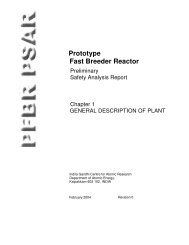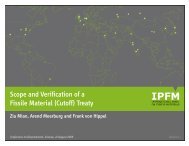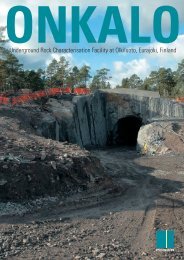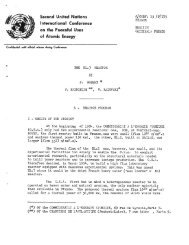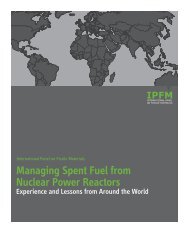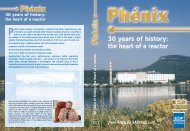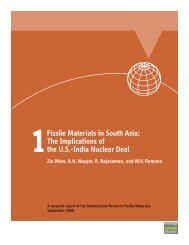Nuclear Proliferation TechnologyTrends Analysis - International ...
Nuclear Proliferation TechnologyTrends Analysis - International ...
Nuclear Proliferation TechnologyTrends Analysis - International ...
You also want an ePaper? Increase the reach of your titles
YUMPU automatically turns print PDFs into web optimized ePapers that Google loves.
PNNL -14480<br />
1) There is a very low efficiency in feed utilization, due to the tendency of<br />
ionized uranium vapor to deposit on all available surfaces inside the vacuum<br />
chamber. Only ten to fifteen percent of the feed material is actually ionized,<br />
meaning that the cut (the ratio of product flow to feed flow) is below .01 for<br />
low enriched feed.<br />
2) Control of the ion beam current is important for various physical reasons. As<br />
the collection rate is directly proportional to the ion beam strength, the amount<br />
of material deposited is limited.<br />
3) To maximize the amount of material arriving at the collectors, the beams must<br />
be focused by adjusting the magnetic fields.<br />
Table 10 lists important technologies and related technical issues.<br />
Technology<br />
Ion Source<br />
Ion Collectors<br />
Vacuum Housings<br />
Magnet Pole Pieces<br />
High-voltage Power Supplies<br />
DC Magnet Power Supplies<br />
Vacuum Pumps<br />
Uranium Recovery<br />
Technical Issues<br />
Obtain high U+ beam currents from source, control expansion of beam, properly<br />
focus ion beam on collector slits, heater life, insulator breakdown, damage to<br />
source components due to high energy ions<br />
Retain and measure collected uranium, retain shape over wide temperature range,<br />
resist sputtering, conduct heat, permit recovery of deposited uranium.<br />
Leakage rate; open and close with minimum downtime<br />
Maintain low magnetic field ripple<br />
Maintain stable voltage<br />
Maintain stable current<br />
Maintain high vacuum in large evacuated region<br />
Substantial chemical processing facility required, labor intensive<br />
Table 10 Technology and technical issues involved with EMIS<br />
3.3.2.2 Changes/improvements in technology<br />
In 1946, Swedish scientists developed an improved calutron design. By varying<br />
magnetic field focus and having the ion beam go through a 255 0 arc, the separation power<br />
could be increased by a factor of 1.5, and higher intensity ion currents could be used.<br />
This type of calutron, called a 255 0 machine, has a significantly higher production rate<br />
than the 180 0 machines 70 .<br />
Efforts to increase the performance of magnetic spectrometers have led to significant<br />
improvements in magnet design, which can increase the ability to focus the ion beams<br />
and increase production efficiency accordingly.<br />
3.3.3 Countries that have used/attempted to use technology<br />
A number of countries have acquired EMIS technology. Table 11 lists those with<br />
significant programs, but only three have actively tried to use EMIS to acquire HEU.<br />
The others acquired single or small numbers of units and used them for other purposes.<br />
70 Iraq’s calutrons: Electromagnetic isotope separation, beam technology, and nuclear weapon proliferation, Andre Gsponer and Jean-<br />
Pierre Hurni, ISRI-95-03, 10/19/95<br />
38



